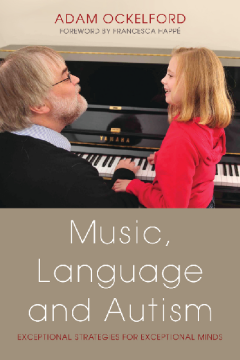
Additional Information
Book Details
Abstract
Children with autism often have an intense natural musicality. This book explains how music and language 'work' as systems of communication, and why music holds such a fascination for many young people on the autism spectrum. There are strategies for showing how music can be used to support language development and even substitute for verbal communication. Exploring the progression from a young child's intuitive engagement with music, to using it as a scaffold for communication, socialisation and understanding, the book illustrates, through the use of detailed case studies, how music nurtures a sense of self and provides a positive outlet to express inner thoughts and feelings without resorting to challenging or even destructive behaviours.
Presenting an innovative approach to the use of music with people on the autism spectrum, this book will be a fascinating resource for speech and language therapists, music therapists, occupational therapists, teachers, teaching assistants, educational psychologists, carers and parents of people with autism.
There are some fascinating insights into the use of music to develop a dialogue with pupils with severe impairments and to enable them to use music as an alternative to verbal communication... This is an interesting book which would appeal to those who have an interest in linguistics and music and who would like to understand better why some young people on the autistic spectrum are so fascinated by music.
KidsCanSucceed - SEN Magazine
Adam Ockelford is a composer, performer, researcher and professor of music who has worked extensively with children with special needs. He gained a Ph.D. in music from Goldsmiths College, developing a theory of musical understanding and development. Adam is the Secretary for the Society for Education, Music and Psychology Research ('SEMPRE'), Chair of Soundabout, a charity that supports music provision for children and young people with complex needs; and founder of The AMBER Trust, a charity that supports visually impaired children in their pursuit of music. He lives in London, UK.
What you will read in this book will awaken you again to sound. Adam Ockelford is a truly gifted teacher, and as a reader we can appreciate that talent as he guides us into the heart of music, with simple explanations of aspects that those without musical training may have assumed were closed to us. This is essential because, as Adam makes clear, music is a space where people with autism spectrum conditions and neurotypicals can truly meet.
from the foreword by Francesca Happé, Director, MRC Social, Genetic and Developmental Psychiatry Centre, Institute of Psychiatry, King's College London
Adam Ockelford is no ordinary music teacher. He is as accomplished in the field of linguistics as he is in music, and has analysed both language and music to identify their common deep structures. Few people could claim expertise in both domains. Even more unique, he has used his insights into how we respond to hearing words and musical notes to support the teaching of children and adults with autism. It was a privilege to hear Adam's blind savant pupil with autism Derek Paravicini playing a piano duet with Boogie Woogie king Jools Holland in Cambridge. Derek's talent is in part his own and in part the product of the special relationship with his lifelong piano teacher Adam. But this remarkable book also reveals the highly original theory that Adam has developed that informs his novel teaching methods.
Professor Simon Baron-Cohen, Autism Research Centre, Cambridge University
There is much that is fascinating in this book. Its message, that not all autistic children are visual learners and music should play a much greater role in their education, is important.
Royal College of Speech & Language Therapists
